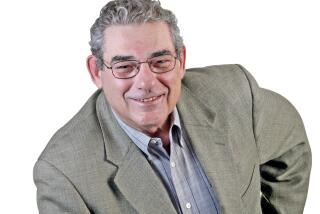Book review: ‘Killing the Messenger’ by Thomas Peele
On a morning in August 2007, a slender masked man ran up to Chauncey Bailey on an Oakland sidewalk and fired two shotgun blasts at the journalist. The first slug tore through Bailey from the side, at shoulder level, shredding the tops of his lungs and his trachea. The second came nearly straight on from the front and tore open his abdomen. The gunman began to run off, but then turned back to fire one more shot that tore away half of Bailey’s head.
I knew Bailey — we were distant colleagues at the Detroit News from 1986 to 1992 — and there’s something deeply chilling about reading the intimate details of his violent death. But that graphic encounter forms only one of many chilling moments in Thomas Peele’s “Killing the Messenger: A Story of Radical Faith, Racism’s Backlash, and the Assassination of a Journalist,” a deeply reported look at the rise and fall of what can best be described as a multigenerational cult of thugs.
Peele’s book begins with Bailey’s murder, as it should, since it was Bailey’s death that ultimately sent Yusuf Bey IV (known as Fourth), a son of Your Black Muslim Bakery founder Yusuf Bey, to prison for life and ended the family’s violent control of North Oakland. But how the Beys rose to such prominence, and the related Keystone Kops behavior of the Oakland Police Department, is the book’s main focus.
At the time of his death, Bailey was editor of the weekly Oakland Post, a freebie paper several rungs down the journalistic food chain from the dailies where Bailey once worked. In truth, Bailey had a loose grasp of journalistic ethics and his work was not exactly top tier, and Peele offers an unvarnished view here of Bailey’s professional weaknesses.
Still, it was his journalism that got Bailey killed. The gunman was a Bey follower acting on orders by Fourth, who feared a story Bailey was working on might expose the criminal underpinnings of the Black Muslim Bakery, which had faded from its 1990s peak when it was perceived as a community force helping impoverished blacks, particularly those fresh from prison. Bailey’s story was never published, and in Peele’s view it might have drawn public attention to the Beys’ efforts to use political connections to influence the bakery’s bankruptcy proceedings (Peele reviewed the 500-word single-sourced and unattributed story as part of his research but was not allowed to take notes).
Bailey’s death galvanized journalists in the Bay Area into forming the Chauncey Bailey Project, in which they teamed to continue the work that Bailey had been doing. The effort echoed the Arizona Project, in which a team of journalists from around the nation descended on Arizona to investigate the 1976 murder of reporter Don Bolles, who was blown up in his car while working on investigative stories into Arizona mob connections.
The Bailey project, of which Peele was a part, never attracted the attention of the Bolles case, a circumstance that drew complaints that the job-related murder of a white reporter at a daily paper would have received much more attention. But that’s a different story than the tale Peele has to tell.
And it is a tale, firmly in the tradition of true-crime books. Peele’s prose occasionally overreaches — he writes in places as though he’s inside the heads of some of the figures, edging over the line between the knowable and the speculative. The neighborhood around the Black Muslim Bakery is the “sagging, blood-splattered ghetto,” and his descriptions of sexual abuse by bakery-founder Yusuf Bey borders on the luridly voyeuristic. Peele’s antipathy to the Beys and the Black Muslim movement also rings loudly, raising questions about his professional detachment; he doesn’t seem to grasp the power of anti-black racism in forging anti-white beliefs by those who are facing systematic discrimination.
Still, the core of the book makes for compelling reading. Peele details (sometimes more expansive than the reader needs) the rise of the Nation of Islam and Bey’s bastardization of its tenets for his own purposes in Oakland. He also explores Bey’s frauds to support the bakery business and tragically poor actions by overworked Oakland police investigators, complete with misfiled investigators’ notes, questionable tactics by an investigator with close ties to the Beys, and Oakland police officials’ astounding two-day delay in a planned raid on the Beys’ compound because two senior SWAT officers were on vacation.
It was during that 48-hour delay that Bailey was murdered.
Peele also gets at the key underlying issue that makes Bailey’s murder resonate far beyond the sidewalks of Oakland. Bailey was a journalist, and he was singled out for murder to silence him. That was not only a crime against Bailey but against a nation that enshrines the notion of a free press in its constitution.
And it is a chilling reminder of the murder and acts of intimidation that confront journalists around the world regularly. Seeking to bring light to the truth can be a dangerous pursuit, even here in the land of the free.
Martelle’s new book, “Detroit: A Biography,” will be published in April.
More to Read
The biggest entertainment stories
Get our big stories about Hollywood, film, television, music, arts, culture and more right in your inbox as soon as they publish.
You may occasionally receive promotional content from the Los Angeles Times.











